OCTOBER KIT
Making Brains Hurt: Tactics for Deeper Teaching
This month, we invite you to experiment with different methods for activating “deeper learning” in your classrooms. According to In Search of Deeper Learning (our grounding text this year), there are specific shifts that characterize the difference between traditional pedagogy and “deeper” teaching.
Our experiments align with those shifts. You may find them familiar or uncomfortable, or a mix of both. Our hope is that you use the experiments to push the boundaries of your “teaching comfort zone,” wherever those boundaries might be today.
Our experiments align with those shifts. You may find them familiar or uncomfortable, or a mix of both. Our hope is that you use the experiments to push the boundaries of your “teaching comfort zone,” wherever those boundaries might be today.
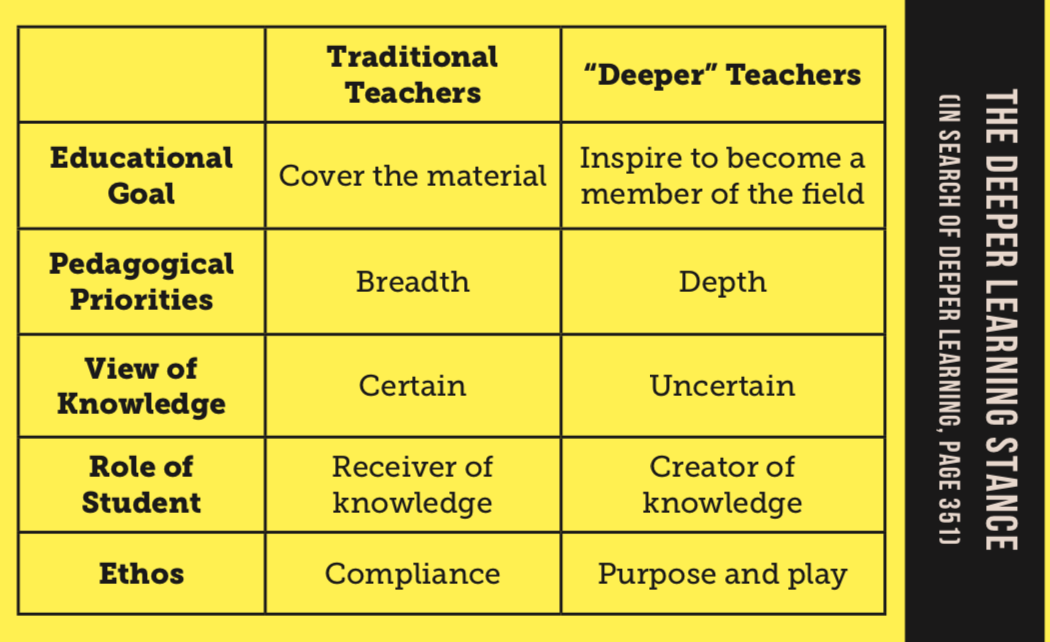
This month’s kit comes in two parts:
• A shared collection of department-specific materials that support your engagement with the experiments. This month’s materials include copies of Wicked Arts Assignments, Draw it with your eyes closed: The Art of the Art Assignment, Making Learning Whole and Dinner Party cards (familiar to folks who participated in SDI this summer.)
• A card deck of five experiments related to this month’s theme. You’ll add to this collection of experiments in each of the subsequent kits.
Preparing for December 8:
On December 8, the whole faculty will reconvene for a showcase called “Show Your Work” where you will share which experiments you’ve tried in your classroom, and how they went. Consider saving examples of the work below in anticipation of the showcase.

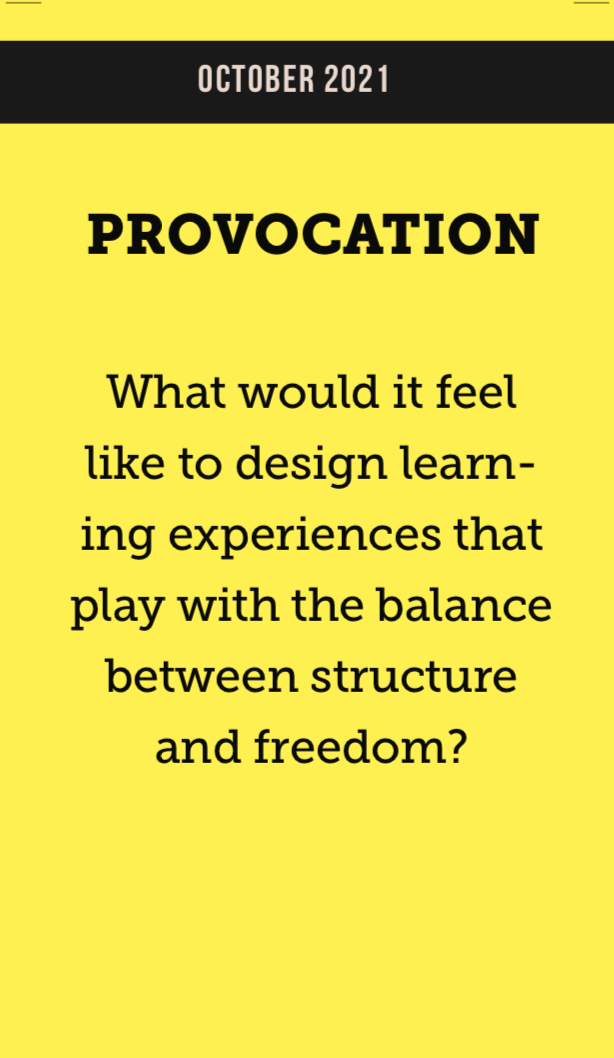
Experiment: Activate purpose and play by designing a learning experience that is inspired by real constraints from reality television shows.
- Watch a clip from a reality competition show like Project Runway, Top Chef or Chopped. Here’s an example from Project Runway – watch from 3:42 - 7:00. (5 mins)
- Discuss: What are the ways Project Runway uses constraints to build a container for designers to create new work? (15 mins)
- What are the constraints imposed on the designers for this challenge? (Responses might include: limited materials, limited time, specific purpose - eg create a high fashion look for outdoor conditions)
- What purpose do these constraints serve?
- How might you use constraints ( e.g. time, ingredients, purpose/program, space, materials, etc) in your classroom to encourage purpose and play?
- Explore our supplemental materials independently or collaboratively to see what this could look like in a classroom and for additional inspiration. Here are some highlights you might find helpful (10 mins)
- Draw It With Your Eyes Closed: The Worst Assignment I Ever Gave, by David Levine - page 66; Ken Horii’s Cardboard Chair Assignment - page 34; Shirley Irons and Kurt Ralske, pages 22-23; Laura Frantz, page 12
- Wicked Arts Assignments: Pages 24-27 (From “Open and Restricted”) or various assignments (eg on pages 80, 90, 114, 130 – but all are accessible and easy to skim quickly).
- Use constraints to design or redesign an assignment in your classroom that balances structure with freedom. (15 mins)
- Speed dating feedback (10 minutes): In pairs, take turns sharing your ideas and getting feedback from your partner about what they find most compelling about the assignment and ask any clarifying or probing questions or offer additional ideas to consider.
- Iterate on your idea (10 minutes): Use the feedback you received from your partner to further refine your idea.
- Implementation: Try it out in your classroom. Document it with pictures, student work or your own written reflections. Bring this to the showcase on December 8.
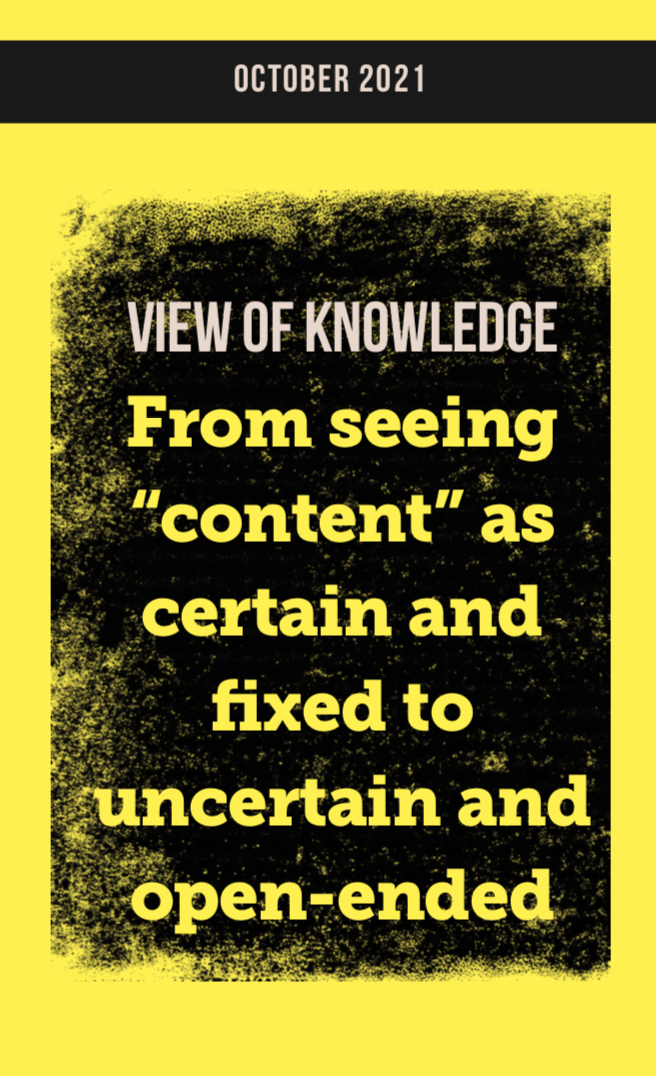
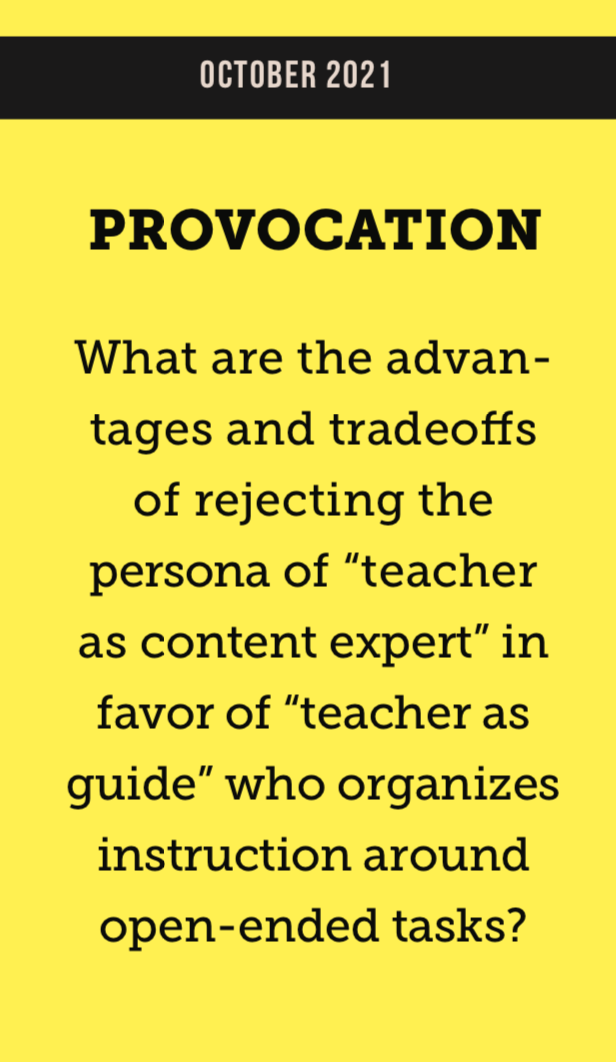
Experiment:
“Give yourself one
photo or one minute
of video to tell a ...
story so perplexing
that all of your
students will want
to know the ending,
without you saying
a word or lifting a
finger.”*
Credit to Dan Meyer!
- Read the quote on the back of the provocation card, then reflect and/or discuss: What does this quote mean to you? What might this mean for your teaching practice? What questions or concerns does this raise for you? (5 mins)
- Take a look at this activity from Dan Myer where the interpretation or approach to a task is uncertain. What’s the first question that comes to mind? Then reflect and/or discuss, What are the benefits or drawbacks of beginning a lesson with an open-ended/uncertain task like this? (10 mins)
- Explore (10 mins): independently or collaboratively www.101qs.com, the #anyqs hashtag on Twitter or this blog post to better understand what this looks like in math and to get inspiration for how you might do something similar in your own classroom.
- Apply to upcoming lesson (15 mins): Redesign at least one upcoming lesson so that it opens with a photo, one-minute video, or prompt that activates wonder.
- Speed dating feedback (10 minutes): In pairs, take turns sharing your ideas and getting feedback from your partner about what they find most compelling about the photo or video and ask any clarifying or probing questions.
- Iterate on your idea (15 minutes): Use the feedback you received from your partner to further refine your idea.
- Implementation: Try out your new lesson in your classroom. Document it with pictures, student work or your own written reflections. Bring this to the showcase on December 8.


Experiment: Using Dinner Party project cards, redesign an upcoming assignment so that it invites students to produce public-facing work that manifests their unique points of view.
- Explore some examples of learning experiences that engage students as producers rather than receivers of knowledge. As you explore, consider the question found on the back of your provocation card for this stance. (5 mins) Note: Projects are only one way of doing this; the discipline-specific examples from In Search of Deeper Learning that folks read in August illustrate other ways of inviting students to express their own points of view.
- Courageous, Eccentric, Diverse: New Monuments for New Orleans
- City Studies: A project of the Center for Urban Pedagogy (learn about the process and take a look at examples of student projects)
- YR Media
- Discuss and/or reflect on the question on the provocation card and also how this is similar or different to your current approach to assignments. What questions or concerns does this raise for you? (10 mins)
- Rework an upcoming assignment using Dinner Party project cards so that it invites students to produce work that demonstrates their unique points of view. Come up with 2-3 pitches to share for feedback. (15 mins) Be sure to consider:
- Does this task/assessment invite students to lean into their role as a producer or “consumer”
- How does the assignment itself represent the work of the field
- Speed dating feedback (10 minutes): In pairs, take turns sharing your ideas and getting feedback from your partner about what they find most compelling about each description.
- Choose one of your ideas and expand on it (25 mins)
- Implementation: Try out your new assignment in your classroom. Document it with pictures, student work or your own written reflections. Bring this to the showcase on December 8.
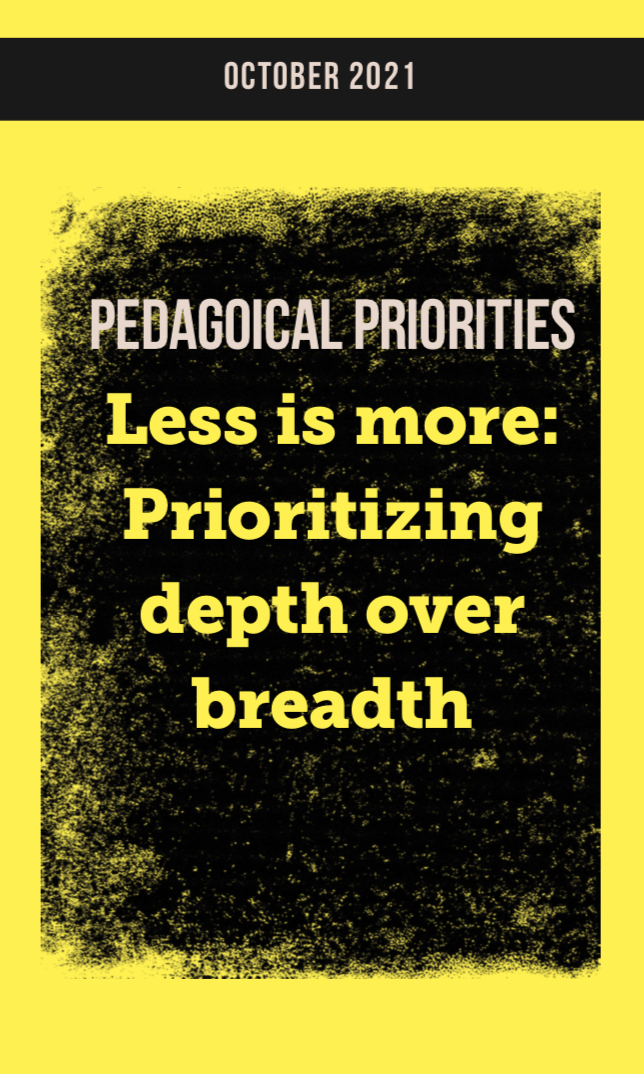
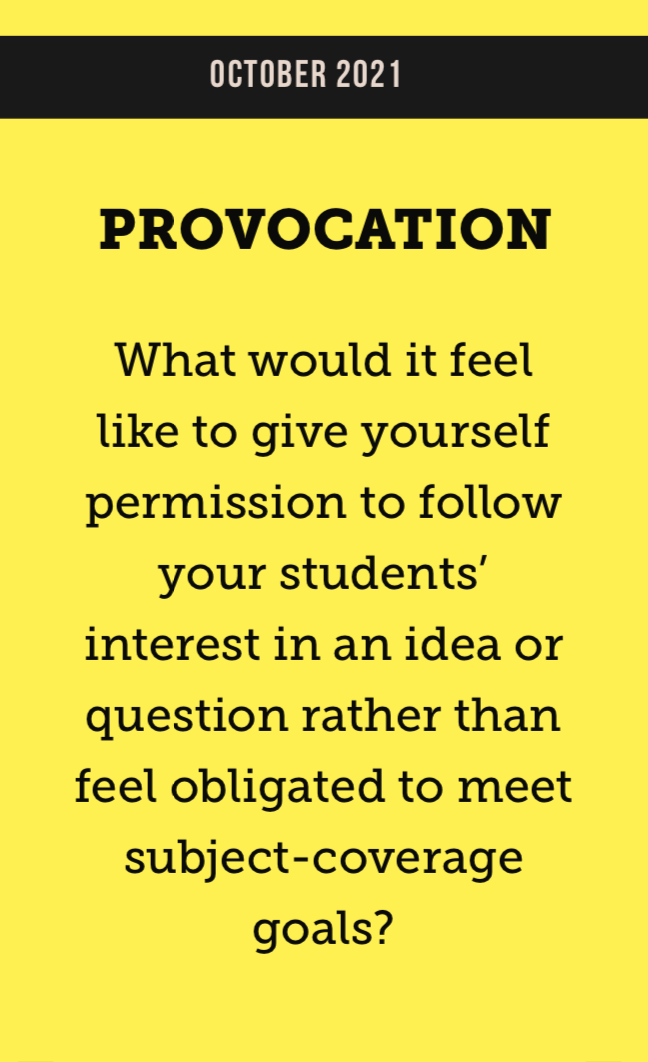
Experiment:
Inspired by college
course descriptions,
design a learning
experience around a
narrow but generative
topic that represents
the ways of thinking
in your discipline.
(Think “Black
Speculative Fiction.”)
- Review course descriptions from the Biology, English and Economics departments at the University of Chicago. (5 mins)
- Then discuss: What do we give up and what do we gain when we teach courses (or HS units) at this scale? What does it feel like to give up breadth for depth?How do these “narrow” topics represent the most important ways of thinking in their disciplines? (10 mins)
- Drawing on your expertise with your curriculum, brainstorm 2-3 generative topics that are narrow, but representative of your field. Write a title and one-sentence description of what you might cover in that mini unit or lesson sequence. Feeling stuck? Here’s the University of Chicago’s entire course catalog: Take a look at the department that most aligns with what you teach. (15 mins)
- Speed dating feedback (10 minutes): In pairs, take turns sharing your one-sentence pitches and getting feedback from your partner about what they find most compelling about each description or ask any clarifying or probing questions.
- Choose one of your ideas and expand on it: What topics might you cover? Over what period of time? What activities would students engage with? Begin to build out your mini unit or lesson sequence that you will try out in your classroom. (25 mins)
- Implementation: Try out your mini unit or lesson sequence in your classroom. Document it with pictures, student work or your own written reflections. Bring this to the showcase on December 8.
- Bonus: Read “Picking what’s worth learning” (Making Learning Whole, page 58-62) about generative topics
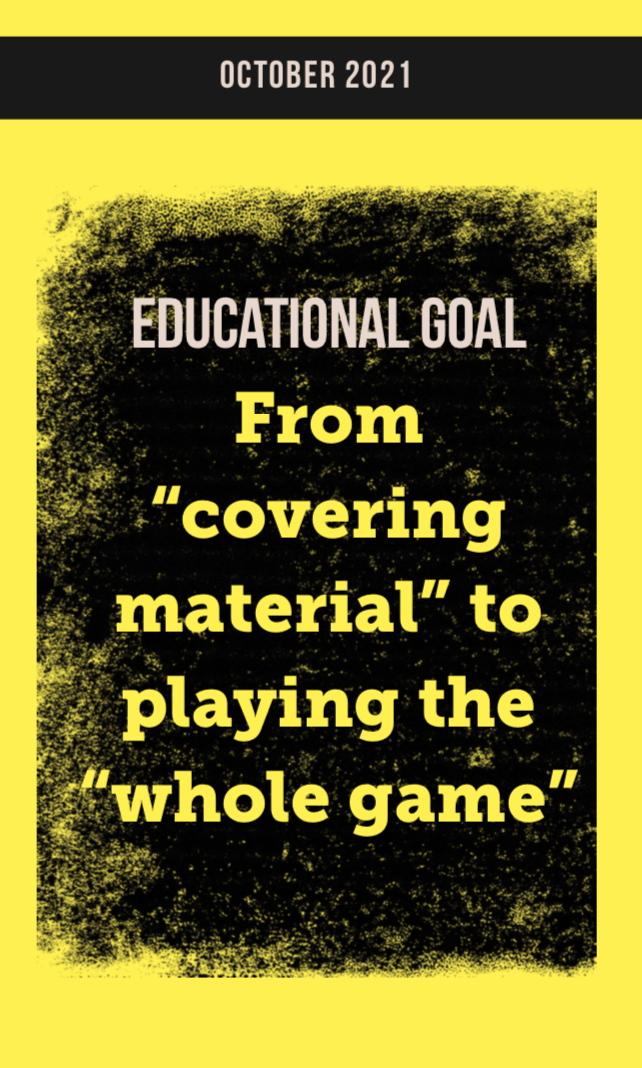
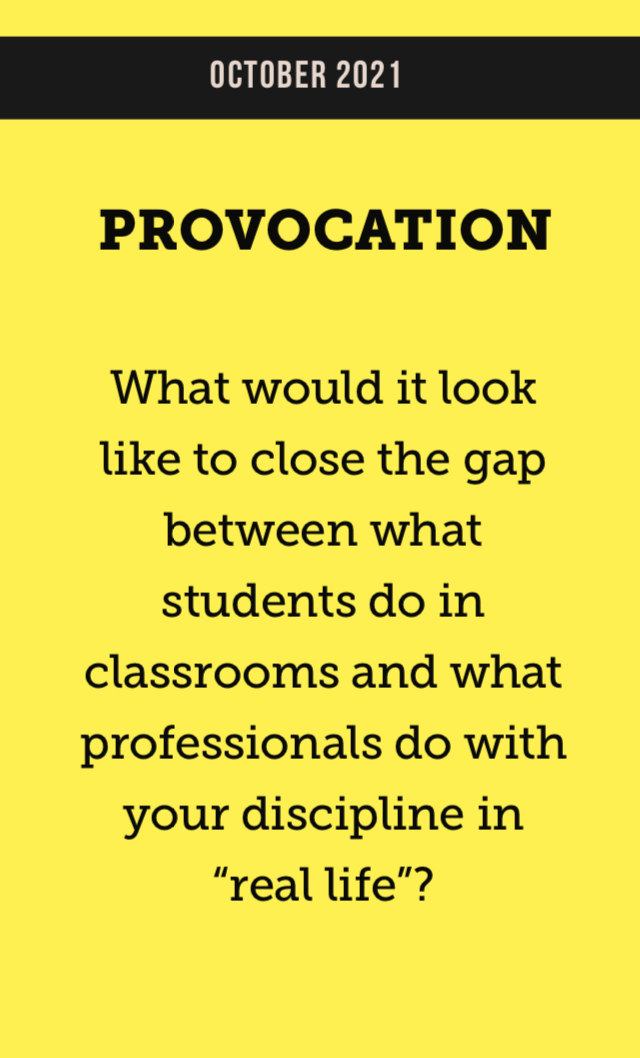
Experiment:
Design an activity
that represents the
whole game in your
field. Consider: What
if the activty wasn’t
just about content, but
also about learners
trying to get better at
doing something?
- Discuss and/or reflect on the prompts below (15 min)
- What is one thing you understand really well?
- How did you come to understand it?
- How do you know you understand it
- Independently read pgs 27-31 for examples of the whole game for inspiration before you go into some individual brainstorming (10 min)
- Bonus: pg 37 (quest for the whole game)
- Bonus: pg 42 (quest for the right game)
- Bonus: pg 295 of Deeper Learning (The Whole Game at a Junior Level)
- Independently brainstorm (15 min): What would it look like to design a learning experience that resembles “the whole game” in your discipline? Identify an upcoming topic/lesson/unit and propose a new way for students to engage with that topic that fulfills the following criteria:
- It involves jumping right in and learning by wholes – that is, it’s a complete activity in and of itself, rather than “preparation” for doing a more complex activity later
- It involves “problem-finding” – that is, students go beyond responding to a teacher-provided prompt to actively asking questions themselves (pg 26)
- It’s not just about content: students are trying to get better at doing something related to the activities that are unique to the discipline. Refer to the profiles you prepared in September. (30)
- Bonus: Find additional criteria on pg 30
- Speed dating feedback (10 minutes): In pairs, take turns sharing your idea and getting feedback from your partner about what they find most compelling about the learning experience you’ve proposed. Your partner should share any clarifying questions that they have or resources that might be helpful in refining your idea.
- Iterate on your idea (15 minutes): Use the feedback you received from your partner to further refine your idea.
- Implementation: Try out your learning experience in your classroom. Document it with pictures, student work or your own written reflections. Bring this to the showcase on December 8.